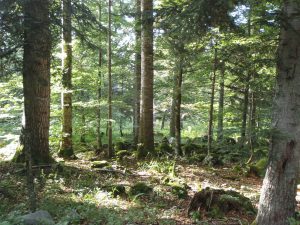Case study
Forests in the European Alps provide a wide variety of ecosystem services (ES) for owners and society by creating income through timber production, protecting infrastructure from gravitational natural hazards, providing high quality drinking water and mitigating climate change through the uptake and storage carbon . Moreover, mountain forests are important aesthetical assets for tourism . However, Forestry is now facing a challenge which consists in achieving sustainability in a changing environment and increasing demand on forest ecosystem services with a better integration of interaction between ecological and social systems .The Vercors regional natural park (VRNP) is a 206,000 ha area located at the border between the Northern and Southern French Alps. 139,000 hectares of VRNP are dominated by forest land, with altitudes varying from 180 m to 2453 m. A mosaic of stands types with different tree sizes and varying species richness are now present. In the Quatre-Montagnes, even though multi-functionality is considered as essential with wood production, recreation and nature conservation being consolidated at all scales.
Nevertheless, the objective is to apply the methodology proposed by the project on the management of the forest in the Quatre-Montagnes forest for the purpose of introducing new management tools that can help forest managers. In particular, the application is divided into two parts; (1) application of the a social-ecological system based analysis, (2) development of a mathematical model based on this qualitative analysis in which we apply viability theory to defined safe operating spaces for forest managers.

Crédit : Peupleloup
As part of this case study, a student was recruited to do a thesis.
Ph.D. title: Coupling the Viability theory and the social-ecological system (SES) framework for a robust and reslient agro-ecosystem management: application to forestry
Candidate: Mojtaba HOUBALLAH
Supervisors:
Jean-Denis Mathias – Senior research scientist, Laboratory of Engineering for Complex Systems (LISC), IRSTEA, Clermont-Ferrand, France
Thomas Cordonnier – Chercheur en Sciences Forestières, responsable de l’équipe EDGE, Unité EMGR, Centre de Grenoble, France
Status: Thesis in preparation at Clermont-Auvergne university (ED 70 Sciences pour l’ingénieur , in partnership with « Institut national de Recherche en Sciences et Technologies pour l’Environnement et l’Agriculture (equipe de recherche) » since 01-12-2016 .
Abstract
The benefits of forests to society and to the biodiversity of life makes it vital that they be protected from deforestation and other potential negative impacts of civilization. Accordingly, it is considered an important practice to integrate multi-functionality and sustainability in forest management. Addressing the complex problem of forest system interaction cannot rely on one discipline alone because the causes and consequences of ecosystem degeneration and regeneration are both ecological and social. A multi-disciplinary framework provides a common language that can be used when trying to understand the pattern of interactions and outcomes occurring in complex systems, thus Ostrom’s SES framework and Anderies robustness framework can be very useful for such analysis. These frameworks enables researchers, from different disciplines, to address a wide diversity of situation that has led to several insights about the management of forests. We argue that SES diagnosis introduced raises questions needed to be answered by modeling tools. Therefore, we seek to propose tools (based on dynamical system theory) that can be embedded in the SES framework. to our knowledge, such an approach has never been used to address these kind of problems. This research is based on a recent work developed by Anderies that gave a first view for connecting the two aspects with practical mathematical model. We aim to develop mathematical tools to enhance multi-functional forest management. We argue that the viability theory is an appropriate tool to face problems of management as it offers flexibility in the decision making process. Rather than managing for a single optimal state, decision makers can manage within a range of acceptable outcomes while avoiding irreversible negative effects on the system. This research is of methodological nature. Therefore, we wish to apply the methodology described above to the Quatre-Montagne case study located in France. Meaning, we apply the SES diagnosis to the case study and then, using this analysis, construct a mathematical model that harmonizes with the diagnosis. We go further by adding on this work and attempt to use a viability-based approach to define operational tools for decision makers to enhance viable and robust management for the forest SES.